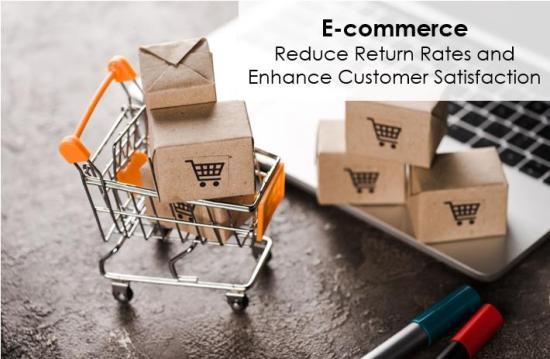With e-commerce return rates hitting 20.8% per online shopper, retailers face shrinking profits and escalating post-sale costs. Brands successfully mitigate return intentions by enhancing the shopping experience, despite consumer expectations for lenient policies.

With the significant surge in overall e-commerce return rates, retailers are grappling with increasingly severe return issues. According to statistics, the average return rate per online shopper is as high as 20.8%, and this trend is continually on the rise. A high return rate not only rapidly erodes company profits but also increases post-sale processing costs, such as shipping, replenishment, sales revenue loss, and return handling manpower. Therefore, despite consumer expectations for lenient or even free return policies, brands need to adopt balanced strategies to meet consumer demands and lower return rates. The good news is that by improving the consumer shopping experience, it is possible to minimize the likelihood of returns.

Causes BEHIND THE RISING E-COMMERCE
The return rate in e-commerce varies significantly due to differences in product categories, prices, target audiences, competition, and other factors. Apparel, in particular, experiences a high return rate, with the average return rate for retailers reaching 24.4% in 2023.
Online shopping only allows customers to see images, making it challenging for them to accurately assess factors like product quality, materials, size, color, and fit. In certain niche markets within the apparel sector, return rates can be even higher, with items like jeans, lower and upper garments, and dresses having the highest return rates. Loose return policies can also lead to frequent returns, with some consumers buying items solely for temporary use, intending to return them after use.
The four core reasons for most consumer returns include poor fit and size errors, product discrepancies from descriptions, changes of mind by buyers, and defective, expired, or damaged goods.
Limitations OF ONLINE Shopping
For products like clothing, shoes, and accessories, ill-fitting sizes contribute to return rates as high as 70%. Traditional size charts only provide general measurements, not accounting for how the product looks on consumers of different body types. Without the ability to try on items in-store, consumers find it challenging to judge the fit when making initial online purchases. To address this uncertainty, some consumers buy multiple sizes of clothing, determining the best fit and returning the rest, inadvertently increasing costs for businesses.
Buying shoes online presents an additional challenge, as foot sizes vary, and there are substantial differences between sizes among different brands. Without proper advice or virtual fitting tools, consumers often order multiple pairs to find the most suitable one.
PROVIDE ACCURATE INFORMATION ON PRODUCT PAGES
To reduce return rates, businesses should prioritize displaying highly accurate details and product categories on their product pages. This fosters trust with consumers, ensuring that actual products align with consumer expectations. For clothing, product listings should include detailed size information, material composition, care instructions, and country of origin. Product pages should feature models of various body types wearing the clothing to showcase texture and fit. Additionally, high-resolution zoom functions enable consumers to see patterns and colors clearly. Fabric swatches accurately display clothing texture, shine, and dye tones on screens, while VR can overlay clothing on virtual models of different sizes. Items like jewelry, electronics, and luxury goods should include 360-degree rotations, video demonstrations, 3D models, and other tools for detailed reference, simulating an in-store viewing experience. Product images should maintain color balance, brightness, and consistent lighting to avoid discrepancies in color, material, contours, and other attributes. Minimizing the options for clothing and shoe sizes and styles enables consumers to easily determine the right fit and style, crucial for reducing returns related to fit.
Effective strategies include providing detailed size charts with actual garment dimensions, offering size recommendation services based on various attributes, displaying user reviews and comprehensive size guides based on consumer feedback, showcasing products on models of different body types, providing consultation services for size and style-related queries, and offering virtual try-on tools where consumers can upload images or create 3D model avatars to preview virtual fittings.

BUILDING TRUST WITH CONSUMERS
Beyond optimizing product pages, businesses should provide high-quality online services (from marketing to purchase to delivery) to build trust with consumers:
- Clear navigation pages and voice/mobile search for easy product location, simplifying complex search processes.
- Clear communication on checkout pages, especially on mobile devices, regarding shipping, refund, exchange, and return policies.
- Proactive pre-purchase communication by customer service via SMS or email, addressing size, material, fit, and style queries.
- Post-purchase emails to consumers containing detailed order information, expected delivery times, and return instructions.
- Timely delivery notifications from the merchant, with proactive communication in case of delays.
ADOPTING QUALITY PACKAGING
Packaging plays a crucial role in reinforcing product and brand quality. Businesses should use boxes, external packaging, and customized product instructions from reputable brands. Surprising consumers with samples, coupons, or promotional items can encourage repeat purchases. Packaging should be easy to open, without sharp edges or excessive tape, to enhance consumer satisfaction. Including return materials makes the return process simple, elevating brand reputation. Providing consumer guides, including product care, features, and usage instructions, deepens consumer understanding.

OPTIMIZING THE RETURN PROCESS
Despite a business's best efforts, consumer returns are inevitable. Businesses can offer free return services, ensuring consumers can choose from various convenient receipt methods, including home pickup and in-store returns. After consumer returns are verified, businesses should promptly process refunds to minimize consumer inconvenience. Additionally, businesses should quickly restore returned items to a sellable state.
For clothing and similar items, partnering with professional third-party organizations can efficiently handle inspection, replenishment, and recycling tasks. Analyzing return data helps understand product trends, size issues, damage situations, and other critical information. Continuous analysis and improvement can refine return policies and product sizes for consumers. In today's rapidly evolving e-commerce industry, adopting the right return strategy is crucial. Customized solutions, from product page design to simplified size guides and high-quality packaging design, can reduce return rates and ensure stable profit growth.
SEKO BANSARD possesses extensive expertise and experience in simplifying the return process through technological means. If you wish to further optimize your return process and implement customized solutions, please contact us at sales@bansard.com. SEKO BANSARD is committed to providing professional support to help you gain a competitive advantage.



